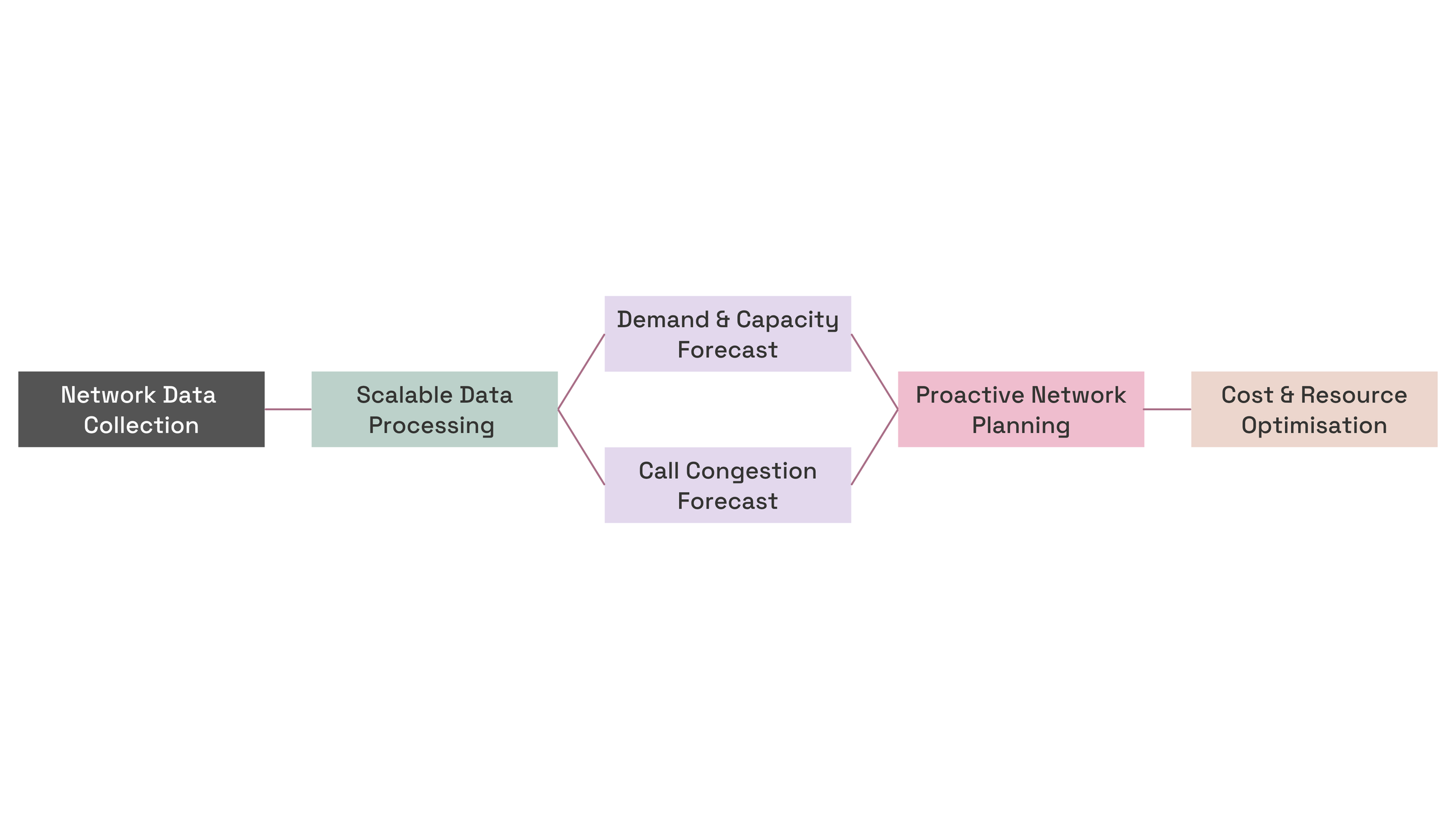
How a subsidiary of a leading Telecommunications Company enhanced Network planning & forecast
Business Impact
Executive Summary
- Client needed to mitigate inefficient capacity planning problems (data silos, delayed infrastructure upgrades etc.) and customer dissatisfaction.
- By deploying a scalable data processing set up, capable of demand & capacity forecast as well as cell congestion forecast, proactive network planning and cost & resource optimisation was targeted.
- The new system reduced Network congestion by 15%, improved forecast accuracy by 20% and lowered customer churn by 10%.
Read the Story…
The Telecommunications industry faces explosive data growth, rising customer expectations, and constant cost pressures. For one major provider, these challenges created critical pain points: inefficient capacity planning, fragmented data, delayed upgrades, network congestion, and growing customer dissatisfaction.
With 5G, IoT, and cloud-native services reshaping the landscape, traditional planning methods proved insufficient. This case study explores how the provider transformed network planning with AI-powered analytics, scalable data infrastructure, and predictive forecast—delivering measurable gains in performance, efficiency, and customer satisfaction.
The Challenge: Breaking Through Data Silos and Planning Inefficiencies
Network performance directly affects experience, competitiveness, and revenue. The client’s traditional, manual methodologies no longer met modern demands.
Capacity Planning Inefficiencies and Data Fragmentation:
Key data (NPIs, KQIs, usage, GIS, external signals) was scattered across legacy systems.
Spreadsheet-driven planning turned real-time needs into weeks-long cycles.
Upgrades were reactive rather than preventive due to limited predictive capability.
Tools lacked robust what-if modelling across multiple scenarios.
Diverse regional patterns complicated coordinated planning.
Delayed Infrastructure Upgrades and Network Congestion:
Planning cycles of 3–6 months lagged changing network conditions.
Resource allocation relied on outdated assumptions without real-time visibility.
Peaks, events, and emergencies triggered congestion and degraded QoS.
5G slicing and dynamic allocation exceeded legacy approaches.
Balancing cost and service quality lacked sophisticated modelling.
Customer Dissatisfaction and Competitive Threats:
Peak-period slowdowns and drops harmed experience, especially in dense areas.
Churn rose as customers moved to more reliable networks.
Premium services underperformed due to inconsistent QoS.
Social media magnified reputation risks.
Meeting SLAs and regulatory requirements grew harder.
The Solution: AI-Powered Network Intelligence
Incremental fixed were insufficient, thus, an intelligent, data-driven ecosystem for real-time analysis, predictive modelling, and automated decision-making was designed.
Scalable Data Processing Infrastructure:
Real-time ingestion of telemetry from base stations, core elements, and devices.
Unified NPIs/KQIs, usage, GIS, weather, and event data.
Elastic cloud compute scaled cost-effectively with workload.
A governed data lake managed structured/unstructured data with lineage.
AI-Powered Demand and Capacity Forecast:
Multi-horizon neural models forecasted minutes-to-months.
Hierarchical forecasts spanned cell, regional, and national levels.
Seasonal/event-aware modelling improved spike predictions.
Deep learning handled non-stationary traffic better than traditional methods.
Ensembles (LSTM, CNN, attention) improved accuracy and robustness.
Cell Congestion Forecast and Predictive Analytics:
Continuous monitoring identified cells nearing thresholds.
Predictive models scored congestion likelihood using real-time and external factors.
Geo-spatial analytics revealed location- and demographic-driven patterns.
Dynamic thresholds and proactive alerts included recommended mitigations.
Proactive Network Planning and Optimisation:
Automated scenario modelling evaluated hundreds of capacity options.
Investment optimisation aligned with predicted demand and ROI.
5G slice resource allocation optimised across services and segments.
Predictive maintenance aligned upgrades with lifecycle needs and costs.
Implementation Journey and Transformation Process
Phase 1 (16 weeks) established a secure, compliant cloud platform, real-time pipelines, and an enterprise data lake; integrated OSS/BSS and network systems; and instituted rigorous data quality, cleansing, monitoring, and governance.
Phase 2 (20 weeks) designed and trained specialised models on 3+ years of history across normal, peak, emergency, and event scenarios; validated extensively; and adopted ensembles to boost accuracy and resilience.
Phase 3 (12 weeks) ran in parallel with legacy processes to de-risk transition, then shifted responsibilities to automated systems with human oversight, supported by team training, feedback loops, retraining, and performance monitoring.
Results: Quantifying Network Transformation
Congestion Reduction (15%): Proactive capacity planning prevented bottlenecks, maintaining speed and reliability during peaks and emergencies.
Forecast Accuracy (20%): Fewer planning errors, better seasonal/event predictions, and improved confidence intervals.
Churn Reduction (10%): Improved reliability cut service-related departures, boosted satisfaction, and enabled premium services.
Efficiency Gains: Planning cycles cut from months to weeks, automated decision-making freed staff, and investments optimised for ROI.
Strategic Impact and Business Transformation
Data-driven strategy became standard: long-term plans aligned with technology evolution and market shifts, capital allocation optimised by ROI and risk, and 5G/NFV roadmaps accelerated. Customer and product innovation advanced via proactive service, personalised plans, QoE gains for streaming and gaming, stronger enterprise SLAs, and IoT/edge enablement. Market leadership strengthened through recognised innovation and operational excellence, enhancing brand, talent attraction, investor confidence, and regulatory relationships. Organisational capabilities matured with a data science culture, cross-functional collaboration, disciplined change management, scaled skills, and a continuous improvement mindset.
Conclusion: A New Era of Intelligent Network Management
This AI-driven, data-rich, cloud-native transformation delivered a 15% reduction in congestion, a 20% improvement in forecast accuracy, 10% churn reduction, and far faster planning cycles—establishing durable advantages in performance, efficiency, and customer experience. Built on integrated high-quality data, AI-first automation, predictive intelligence with continuous learning, and deep business–technical collaboration, the organisation became future-ready for evolving 5G, edge, and virtualised services, sustainable operations, and sustained competitive leadership.
Share this Post
Read More Success Stories









